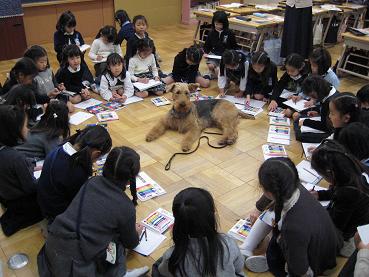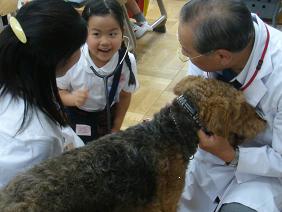|
Our school dog is called Buddy. She is a friend of the students and loved by all. She is a female Airedale terrier born on March 11th, 2003. Every day she goes with me to St. Margaret's Elementary School, a private school in Suginami, Tokyo where I work. The school has made a special place for Buddy in one corner of the teachers' room. Buddy accompanies me to class every day, goes for a walk with children on the school grounds during recess, and attends school events. Since the end of World War II, many public schools in Japan have made raising an animal and caring for it part of education. In most cases, the children are placed in charge of caring for rabbits or chickens in a hut or shed on the school grounds. Unfortunately, however, many schools do not seem to have the proper training and capacity necessary to take care of such small animals. |
 |
When others find out that our school has a dog for educational purposes, we are often asked questions like: "Why do you keep the dog at school?" "Is it a dog for animal therapy?" "Why is there a dog at school?" "Why is it an Airedale terrier?" Keeping a dog for educational purposes requires dealing with hygiene management, accident prevention, expense and proper environment for the dog, and achieving a consensus of parents and within the school. Guidance and help from veterinarians, dog trainers and breeding specialists are indispensable. Here, I'd like to introduce a new educational program--Animal Assisted Education--and some of its practices and results so far.
Teaching the Importance of Life
How can we teach children the importance of life? It is an important educational issue today. In fact, the government guideline for teaching specifies the goal and content of moral education as follow: "Know that life is irreplaceable and value our own and others' life." This also applies to private schools. For example, in our school, which is a Christian one, emotional education and cultivation of sentiment are a part of religious education and considered to be goals of education.
As a teacher of Bible Studies, my intention was to teach the students about the themes of "life" and "feeling" through prayer and reading the Bible. One incident, however, made me wonder if I had really been able to teach them the importance of life. One day, two second-grade students came and showed me a dead cricket. They were both sad, and asked me to give the cricket a funeral. I felt that I needed to do something. Even though it was an insect, I felt some respect for life from them and decided to conduct a funeral. The children and I made a grave for the cricket and then prayed. The funeral was a success. The next day, the two children came with a dead grasshopper and asked me if they could have a funeral for that dead insect, too. Then the following day, they came to me with another dead cricket. By that time, we were having a funeral every day, and I felt that our mourning had become shallow and that we were merely acting out the funeral. The boxes where the insects were kept in the classroom had no soil, not even a piece of grass. In the box, there are small insects making quiet sounds. Under these circumstances, it occurred to me that if an insect stopped moving or died, someone would insert a new insect in the box, like replacing a broken toy. I personally believe that small insects didn't look real enough to teach the children the importance of life. How could I show the students how important life is? The world today is dominated by virtual reality. Everybody, even children, has cell phones and can watch TV in the palm of their hands. But, shouldn't the children learn the feeling of living and the realities of life?
School is one site where children experience growth, but how do they experience the realities of life there? Most schools keep small animals for students to learn the importance of life by taking care of them. The teachers work very hard in their daily schedule to teach the children about life with animals. However, many schools do not have the capacity to care for animals appropriately or the ability to use this experience effectively. What does the existence of animals mean to children? Having a dog at school has brought me many new encounters, experiences, and taught me many things. I hope that more children, through their interaction with the dogs at school, will come to have a respect for life and understand its importance.
It will be fun to have a dog at school
The idea of having a dog at school came to me when I met a girl who had been frequently absent from school in the past several months. She stayed at home, spending time alone, without ever going out. I kept in contact with her by phone and e-mail, and one day, we decided to take a walk together to the park with our dogs. As we walked our dogs, we talked about different subjects and made it a practice to walk our dogs together in the park on weekends. Her confidence in life came back, and she started coming back to school. Then she secretly mentioned, "It would be fun if we could have dogs at school."
The children grow daily, as they experience stress and struggle. For the students who refuse to attend school, school is a place that makes them tired of learning, connecting with people, and competing, but if it is a place where they can spend time with a dog who is good companion, they can feel secure and reassured at school. It also gives them the courage to come back to school. If the dogs become a source of joy and kindness in school, children will experience less stress and worry. Dogs could also help some children cope with stress. These were my initial thoughts as the idea of having dogs at school took shape.
Introducing the New Education Program
In 2001 IAHAIO (International Association of Human-Animal Interaction) was held in Rio de Janeiro, Brazil, where it was reported that animals can play a role in the emotional education of children. Guidelines for the implementation of Animal Assisted Education were set forth as the Rio de Janeiro Declaration, which included requirements and precautions when caring for animals at school. There were few precedents to use as instructive examples, and research in this area has now only begun.
This program promises to be effective in building human relationships and promoting children's growth and development. We have consistently improved this program with help and input from specialists in the care of animals and education. At first, some teachers expressed negative thoughts and uneasiness. These worries ranged from who was going to take care of the dogs to dog bites, allergies, and hygiene. Fortunately, this problem was solved by allowing doctors, veterinarians, and dog trainers to take part in this educational program. We finally received approval on a trial basis, with myself assuming responsibility for the selection, purchase, feeding cost, and the care of the dogs.
Thus, the attempt at the new education program, Animal Assisted Education, began with the Airedale terrier Buddy in 2003.
The Birth of School Dogs
In establishing Animal Assisted Education, we received the help of many people both in Japan and abroad. A veterinarian, who is also a breeder in Hyogo, Japan, helped us get a puppy that is a pedigree dog from the former East Germany and known for working well with the Japan Police Dog Association.
Our school dog was born on March 11, 2003. The school chose her because, among the others in the litter, she was the calmest and would get along best with children. Hoping that she would be accepted as a friend, we named her "Buddy." At a rather early stage, fifty-five days after birth, Buddy came to Tokyo to get vaccinations and underwent various kinds of socialization training to become accustomed to the children and the school environment. When Buddy was 70 days old, she came to our school, and for the first two weeks, only children who had volunteered to care for her were allowed to get close to her. Buddy's activities and interaction in the school were then expanded in stages, so that 3 months after birth, Buddy had become friendly with over 100 people. Because Buddy's experiences have been positive and affirming, she tends to be a little shy and passive, but she is still a wonderful companion for the children.

Buddy Walkers
Buddy was given a corner in the teachers' room, called the "Buddy Room," at the age of two and a half months in order to help her adapt to the school environment. Sixth graders are responsible for taking care of Buddy, and this includes taking turns with the morning feeding, walking her so she can urinate, and cleaning her area. A group of sixth graders, called the "Buddy Walkers," has volunteered to help take care of Buddy at school. These thirty children, who make up half of the sixth grade, are required to take a dog handling course in order to officially become a "Buddy Walker," as knowing how to handle and care for a dog is one condition for the job. The children are doing their best to learn how to handle a large dog. At first, they are confused and struggle with the program, but they learn how to clean up after a dog and deal with any problems that can occur. They receive regular instruction from a dog trainer and are building a good relationship of trust with Buddy.
Taking Part in School Activities and Help from Dog Professionals
In order for Buddy to become closer to the students, the school has decided to allow Buddy to take part in school activities. These activities include camping in Karuizawa, Field Day, and Christmas parties. Buddy has become a very important part of the children's lives. She helps children at camp to overcome homesickness, and during school excursions encourages those who are not used to walking long distances to keep on going. I have also noticed that the children do not relate to Buddy as her master, but as a friend.
In the beginning, there was skepticism about the positive effects of this program. As the program steadily continued, many of the skeptics began to see with their own eyes how the children and Buddy had bonded. As a result, the program now receives wide approval and support.

I must also mention the health issues involved in keeping a dog at school. Besides rabies shots and others shots to prevent contagious disease, it is necessary to consult veterinarians and specialists to make sure that dogs, who spend so much time outdoors, stay healthy and to ensure that children's allergies are not affected. A dog trainer visits the school a couple times a year to give classes on dog behavior. A veterinarian visits to give lectures on dog care, health and other topics related to raising a dog.
Since it began on May 2003, the program has been operating very well. We will provide an update on the program in the future with more information and examples of the educational effect of this program on children.














